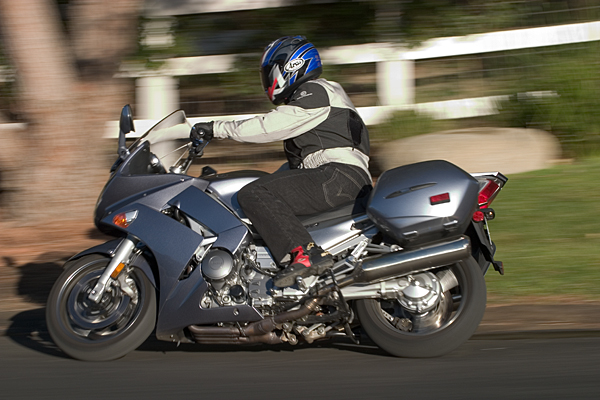
After our first riding impression aboard the big FJR1300AE (automatic clutch version), as well as its sister with the normal, traditional clutch operation, we obtained a bike for more extensive street testing. The version provided was the 1300AE (automatic clutch). In case you are wondering, the 2007 FJR is now available, and is unchanged from 2006 (except for color), so this review can be considered in evaluating the 2007 model.
All of the technical aspects of this bike worth discussing were discussed at length in our earlier first ride impression here. After spending some time with the new FJR, my impressions were, in some respects, similar to those from the press introduction ride. The ergonomics are comfortable; the new windshield offers a tremendous range of adjustability, and does seem to solve most, if not all, of the buffeting issues associated with the prior screen (including the prior screen’s tendency to “suck” you forward into a vacuum when the screen was raised).
I left the newly-adjustable seat in its higher position (allowing me to stretch my legs a bit more on longer trips) and was very happy. More than two hours in the saddle at a time did result in some seat discomfort, but nothing more than one would expect on longer rides. Overall, the shape of the seat and its foam density seemed about right, and the rider can shift positions slightly to add some variety, and provide some relief during longer trips.
Basically, with regard to touring ergonomics, the FJR provides an upright, comfortable riding position with better wind management (including that newly-designed, adjustable windscreen). Not a lot to complain about in this category.
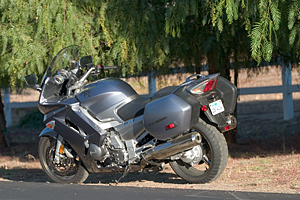
Engine performance is another area where the big FJR delivers everything you ask for, and probably more. The 1298cc in-line four delivers mondo horsepower and torque virtually everywhere the tach needle may be be pointing at any given moment. The big sport tourer will grunt out of tight corners while the engine lopes at low rpm levels, and rip forward as the tack needle sweeps across its range (redline is at 9,000 rpm). If there is a faster, more torque rich sport tourer available (and there may not be until Kawasaki releases the Concours 14 later this year), it shouldn’t make much difference — for moving one or two passengers, with or without luggage, the FJR1300 offers all you would ever need in terms of torque and horsepower.
I really like the refinements Yamaha has made to the chassis of the new FJR, including the lengthened swingarm discussed in our earlier riding impression. The bike is now sprung stiffly enough to provide real entertainment on back roads, without beating you up on the highway. The easily adjustable shock preload (with 2 positions operated by a simple lever) are much closer to where they need to be these days (on some earlier models, these preload settings were far too soft). I ran the shock in the softer position, despite weighing over 200 pounds. The stiffer position should accommodate most rider/passenger combinations well. Of course, it would be nice to have an even wider range of shock preload adjustment.
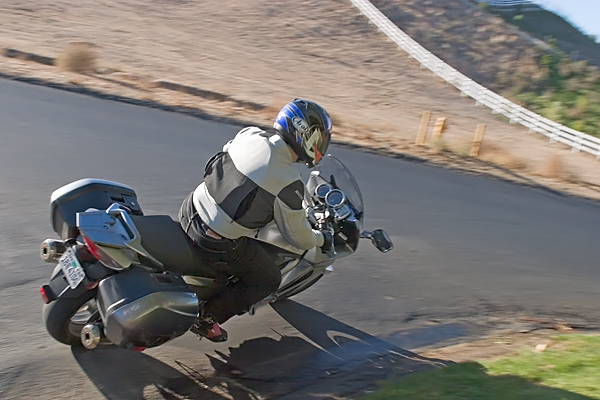
Braking is also difficult to fault with the big FJR. Power and modulation from the linked system are certainly above average for this category, while not quite at modern sport bike levels. The bike is also equipped with ABS.
You are probably wondering how we got along with the automatic clutch system (described in greater detail in our introduction article). The short answer is not very well, and I am afraid that I would have to recommend the standard clutch to riders of just about every skill level. Why? Take a look at my initial complaints in the press introduction article. With more experience on the bike, the performance of the automatic clutch actually became more annoying to me.
Low speed maneuverability can be tricky, as we previously pointed out. My long-term tester also seemed a bit more abrupt when transitioning from closed throttle to open throttle (a combination of the automatic clutch performance and the fuel injection on the FJR). While this was a complaint I had initially, with more time, I actually became more annoyed with this aspect of the bike’s performance.
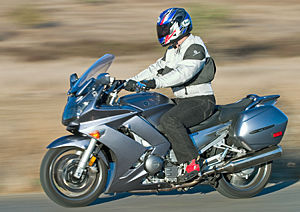
Pulling up to stop lights, and pulling away from stop lights, I frequently felt like a beginner rider as the FJR bucked and lurched. The clutch seemed to engage and disengage rather abruptly, preventing stops as smooth as I normally experience, and also preventing acceleration from a dead stop that was smooth and progressive in the manner delivered by a normal motorcycle with a clutch that can be slipped by an experienced left hand.
The FJR does not provide the world’s smoothest fuel injection system in terms of transitions from closed throttle to open throttle — even with a normal clutch — but it is not bad. Coupled with the automatic clutch on our test model, however, this exacerbated the problems I described above, and was annoying on slow corner exits.
Instrumentation is very important on a sport tourer, and Yamaha has decked out the FJR1300 with just about every form of feedback you might need (and some you probably won’t). With highly legible, traditional analog tachometer and speedometer complimented by an LED screen, you have all the usual information available to street riders, plus a handy gear position indicator, fuel level indicator, coolant and air temperature gauges, and a clock. A computer also provides information on real-time mileage, and average mileage. Aggressive riding will put your miles per gallon in the low 40s according to our testing.
Night time riding was aided by excellent headlights that can be easily adjusted up or down with a knob (particularly important when carrying varying passenger/luggage loads).
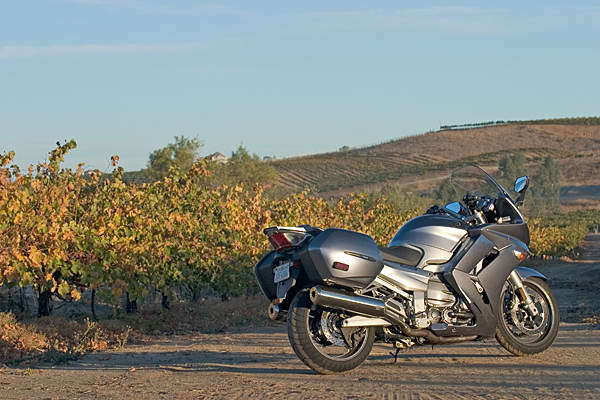
The glove box 12 volt outlet is very convenient, as is the similarly located heated grip adjustment. The temperature of the grips can be controlled with a rheostat-style adjustment near the top of the glove box. With some trial and error, you can find a temperature that works for you on just about any given cold weather outing. The grips can feel too hard on longer trips, however, and you may decide to address this with thicker/padded gloves.
The saddle bags on the FJR are well designed and easy to use. They each are capable of holding a full-face helmet, and Yamaha has available canvas bags that fit neatly into each compartment, creating a more convenient carry system when off the bike. Capacity is about average for a modern sport tourer — at least in my experience. The new, narrower design of the bags did give me a bit more confidence splitting traffic here in Southern California, where I was now able to focus on the rear view mirrors as the widest point of the FJR.

The only other real complaints we had about the FJR concern some vibration at freeway travel speeds (above 70 mph) that affected the rear view mirrors, and the hefty throttle spring. The mirrors become buzzy at higher freeway speeds — preventing a clear view of traffic behind you. Although a minor issue on a sport bike, this can become a significant issue on a sport tourer. Interestingly, we did not notice as much of a problem with vibration in testing prior models of this bike.
The throttle return spring is too stiff, and can be tiring on longer rides. There is apparently a way to adjust this spring tension, but we did not attempt it.
All-in-all, Yamaha’s FJR1300 is a popular sport tourer for good reason. It offers big power, competent handling (particularly with the chassis updates for 2006) and long distance comfort. It has a large fuel tank (6.6 gallons) with excellent range, good headlights and outstanding, legible instrumentation. With shaft drive, it should be dependable and require little maintenance for years. It is a bike you should definitely take a close look at if you are in the market for a large sport tourer. In our opinion, however, steer yourself towards the version with the traditional clutch.
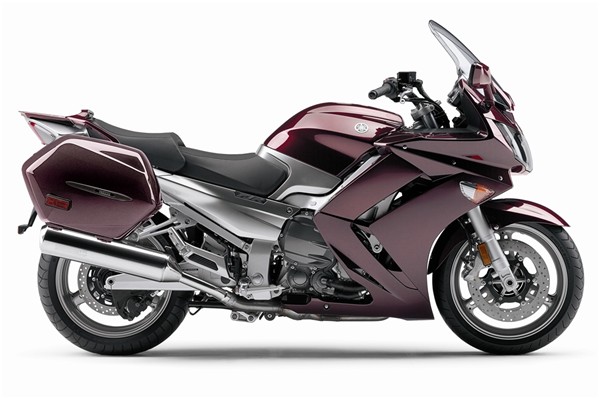
MSRP for the FJR1300A (standard clutch) is $13,799, while the FJR1300AE (automatic clutch) is $15,599. The 2007 model (pictured above) is unchanged except for the new Black Cherry color of the FJR1300A model. For additional details and specifications, visit Yamaha’s web site here.





